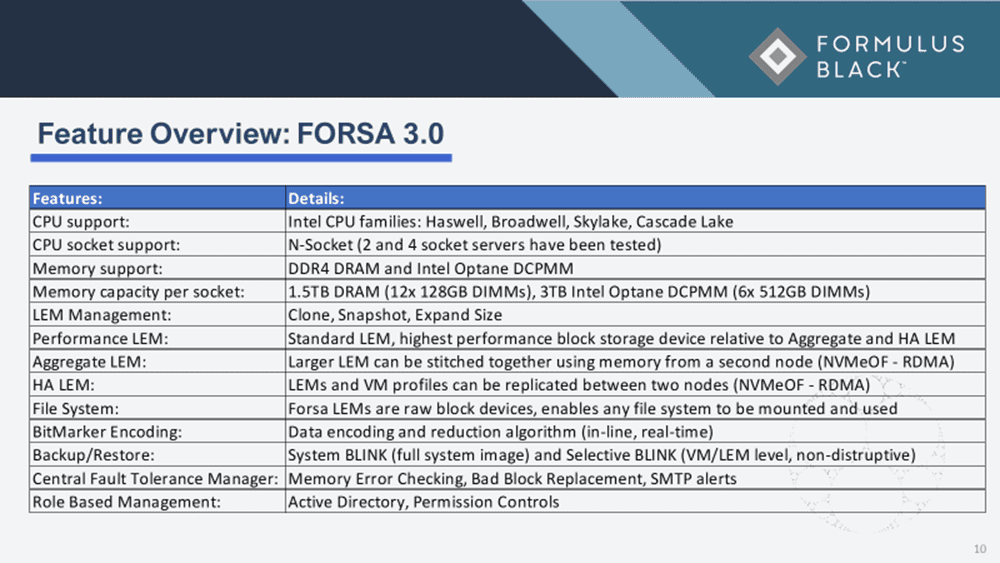Formulus Black has an in-memory app acceleration software product that significantly speeds application performance for databases, machine learning, etc. The CEO, Mark Iwanowski, will be talking about his vision for the company in this interview.
As the New CEO of Formulus Black, please tell us about yourself and your experience before now?
I am a three-time serial entrepreneur and previous Oracle CIO. I also was in the VC world as a Managing Director with Trident Capital. While at Oracle, we were constantly faced with I/O and CPU challenges as the amount of data running through our software continued to grow at an exponential rate. When I learned about the great things Formulus Black was bringing to the market to address these performance issues, I was excited to get involved as the cost of memory was continuing to drop to the point where it had become a viable option to legacy storage solutions.
What does Formulus Black provide to customers?
In a nutshell, our product Forsa allows memory to be used as storage with all the equivalent functionality for high availability (HA), scale out, virtualization and other functionality inherent in legacy storage solutions.
What are the problems facing today’s applications, what is a Memory-Converged Infrastructure and why is Formulus Black the answer?
Due to the exponential growth of data, databases and other applications are constantly being pushed to the limit regarding I/O performance. Forsa provides the ability to have the data being processed to sit much closer to the processing CPU, in order to accelerate workloads up to ~70 times faster even when compared to data that persists on “fast” NVMe SSDs. Note that SSD storage, although significantly faster than spinning disk is very slow in comparison to using memory as the data storage medium.
Are there other software providers like Formulus Black, what major features or services make Formulus Black unique?
Unlike In-Memory databases, Forsa does NOT require changes to underlying databases or applications and is much less expensive and time consuming to deploy. In addition, we have a function called Bit Marker that allows more efficient use of the available memory space when there is any redundant data that the algorithm can detect. The Bit Marker algorithm detects these patterns in real-time before the data is even written to the physical memory media.
Could you give us a walkthrough of how Forsa 3.0 works. What is the technology behind the software?
We would be happy to provide a demo of the software. The following chart summarizes the enhanced functionality found on Forsa 3.0.

Tell us more about the collaboration between Formulus Black and Intel, what are the benefits?
We are very excited about this partnership. As you may know, Intel has introduced a high-performance memory and storage solution called Intel Optane DCPMM (stands for DC Persistent Memory Modules). This new Intel solution has an option called “app direct” mode that enables Optane DCPMM to support data persistence. Our current 3.0 implementation works on Optane DCPMM in a non-persistent “memory mode”; however, Forsa has demonstrated performance enhancement over the Linux native implementation for Optane DCPMM data persistence while bringing a suite of functionality enhancements mentioned in the last question as well as in the table comparing Optane DCPMM on Linux native block devices vs. Forsa LEMs below. We are currently working to complete our 3.1 release targeted for GA in early Q1 2020, where Forsa will support data persistence in “app direct”mode.
Since the Product Launch of Forsa 3.0, what are your success stories so far and what is next on your roadmap?
Since coming out of stealth mode earlier this year in March we have successfully sold Forsa 2.0 to customers in the telco/communications and university research spaces. Looking ahead, we have a robust pipeline of over 65 Forsa 3.0 prospects that we are now working through to drive pain relief I/O intensive workloads.
Are there any current opportunities for investors and partners at Formulus Black?
We have a strategic partnership with Packet, a bare metal cloud provider that allows us to offer our product in the cloud as well as for on-premises customer applications. We also have a new partnership with an Intel Platinum VAR, Geelers, that will be our go-to market partner for joint Intel/Forsa bundled solutions. We are in active discussions with a variety of other OEMs, including Dell/EMC, Lenovo and others to explore similar relationships.
We are in the process of closing an internal extension to our B round and are already exploring potential inbound interest for a subsequent strategic round in the Spring of 2020.
Please you tell us about your team and customer support?
Our core development and product support team work out of our Jersey City headquarters office and we have an extended dev/test team in India.
How does Forsa 3.0 ensure uptime and data integrity for applications placed in-memory?
Forsa 3.0 includes an HA and UPS option. Re data integrity, we have a Central Fault Tolerance Manager that includes memory error checking, bad block replacement and SMTP alerts. Customers can also use Forsa’s BLINK capability to create system state backup and restore points at the server and VM/LEM level.
Do you have more information for our readers?
Below is a link to the product section of our website which provides additional detail on the company’s technology – https://www.formulusblack.com/product/.


































